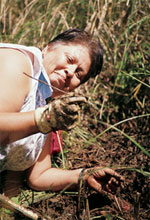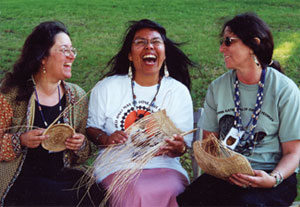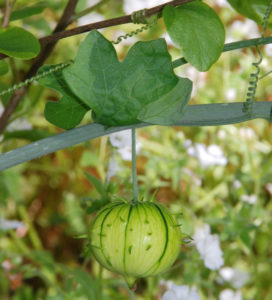The Indian’s preservation of the land and its products for the ten thousand or more years of their undisputed occupancy was such that the white invaders wrested from them a garden, not the wilderness it salved their conscience to call it.—Theodora Kroeber and Robert Heizer, 1968
Hike through the 65 parklands that comprise the East Bay Regional Park District, and you can rejoice at the astonishing diversity of plant and animal habitats protected within the East Bay’s largely developed, urbanized landscape. This includes a number of rare and endemic species, from the Mount Diablo globe lily to the salt marsh harvest mouse. At the same time, we can reflect on the many changes that have crept across these parklands, which, while appearing so natural at first glance, have been dramatically transformed since the Spanish first traversed parts of the East Bay between 1769 and 1776, their routes defined by existing Indian trails.
Since then, the landscape has been degraded to varying degrees. Some of the changes are obvious: the abundance of introduced plants, including exotic, annual grasses; the complete absence of grizzly bears; and the presence of possums, feral cats, and wild pigs. One of the greatest changes rests in the discontinuance of an aspect of land use unknown to most modern people—California Indian land management practices.
Local tribal peoples had an intimate connection to the land, living with it rather than on it. They consciously and conscientiously reshaped it through the use of such horticultural techniques as burning, pruning, and digging, enhancing many species while suppressing others. These methods resulted in a world well suited to plants and animals upon which people relied for food and objects that blended utility and beauty.
A mere 236 years ago, the East Bay was home to some 25 tribes, whose members spoke variants of Bay Miwok, Ohlone (Costanoan), and Northern Valley Yokuts languages. In most areas their villages, inhabited by some 60 to 90 people, occurred every three to five miles along streams.
After non-Indians intruded, local tribal peoples endured much suffering and severe cultural disruption. Today nobody knows exactly what the landscape they managed looked like. Specifics of local land management practices must be inferred from obscure journals, diaries, and other early records; information shared by Ohlone elders in the 1920s and 1930s; the techniques applied by tribal peoples in areas that weren’t impacted as early on by non-Indians; and what we know from the techniques still practiced by indigenous peoples across the state, including some Ohlone. As a result, we know more about the management of particular species than of whole ecosystems.
There can be absolutely no doubt, however, that local Native peoples did indeed manage whole ecosystems to great effect. In 1792 British naval captain George Vancouver traveled overland by horseback from Mission Dolores in San Francisco to Mission Santa Clara. Vancouver described a riparian corridor with “a very pleasant and enchanting lawn, situated amidst a grove of trees”:
“We had not proceeded far from this delightful spot, when we entered a country I little expected to find in these regions. For about twenty miles it could only be compared to a park, which had originally been closely planted with the true old English oak. The underwood that had probably attended its early growth had the appearance of having been cleared away and had left the stately lords of the forest in complete possession of the soil.”
These open stands of mature oaks did not simply make their own way in the world. For centuries, Native peoples burned the understory—most likely in some cyclical practice of low-intensity burning—thereby affecting water and mineral nourishment for the remaining oaks.
For the people who fostered this fertile landscape, a diverse set of laws and spiritual practices underpinned the more practical aspects of day-to-day land management. These practices codified one important tenet of daily life that humans must always give back for what they take and use, or, as Julia Parker (Coast Miwok/Kashaya Pomo) puts it, “We take from the earth and say please. We give back to the earth and say thank you.”
Like indigenous peoples throughout the continent, local Native peoples believed that the earth and sky and all objects in between had life and consciousness. They recognized the existence of an interrelated system of powerful, usually ambivalent, supernatural forces. The world had the potential for both good and bad, not in the sense of right and wrong, but as an expression of harmonious and inharmonious elements. These component forces were in harmony when under control, but had the potential for illness or catastrophe, such as a poor harvest, if uncontrolled. People kept the world harmonious through prayerful thoughts, actions, and offerings; adherence to rules of proper behavior; and the observance of spiritual dances in proper seasons on a yearly cycle.
- Linda Yamane (Rumsien Ohlone), Lydia Bojorquez(Kakoon-Rumsien Ohlone), and Carol Bachmann (Mutsun Ohlone), weavingtogether at Coyote Hills Regional Park, home of the Park District’sprograms on traditional Native practices. Photo by Linda Yamane.
From the perspective of the first peoples of this land, every plant community had its own requirements for human interaction. Three of the most important were grasslands, oak woodlands, and riparian corridors. While people along the margins of the Bay and ocean obtained an incredible amount of shellfish and other kinds of seafood, grasslands likely contributed the greatest abundance of plant and animal foods. Local tribal peoples expertly applied two specific management techniques to grasslands judicious but wide-ranging use of fire, and cultivation through digging.
The journals of early Spanish expeditions in the Bay Area are rife with references to pinole (seed cakes) and, to a lesser extent, atole (acorn soup), amole (soap plant bulbs), and cacomites (brodiaea corms). For local tribal peoples, pinole was an extremely important source of food, by all indications comparable to acorns. Roasted for a short time, brodiaea and other corms, bulbs, and tubers sweeten deliciously. Though also used for soap and whisk brooms, soap plant bulbs, baked in a pit oven for two or three days, acquire a sweet, juicy taste.
Fire often promotes the health of seed-bearing grasses and forbs, including those used in pinole. Fires set annually by local tribal peoples moved slowly across the landscape because there was little fuel buildup. The fires burned low and cool, leaving unburned patches and preventing the encroachment of shrubs that would otherwise intrude on open grass and meadowlands.
These fires transformed dried plant material from the tops of grasses and forbs into nutrient-rich ash to fertilize new growth. This new growth provided the tender plant material sought by foraging animals N including tule elk, pronghorn antelope, and black-tailed deer which were, in turn, hunted by the men. California Indians traditionally used fire-hardened, hardwood digging sticks to till the soil loosening, aerating, mixing in nutrients, and removing competing plants. Each year, by gathering the mature bulbs of such plants as brodiaea, soap plant, and wild onion, the harvesters provided room for the immature bulbs they left behind to flourish.
Unfortunately, nonnative Mediterranean grasses began to displace native forbs and bunchgrasses, and the Spanish outlawed Native burning practices to promote cattle grazing. By 1787, the priests at Missions San Francisco and Santa Clara noted that intensive cattle grazing and land clearing had resulted in the decimation of the seeds that Native peoples used in pinole and the forbs they used for greens.
Today, while walking along certain regional park trails, we can see some of the plants that produced these foods looking as if they were still managed, because of their relative abundance, health, and growth patterns. Although the red maids, chia, narrowleaf mule ears, blue wild rye, and fescue that were used to make pinole no longer grow in the large numbers they once did, you can walk out to the northeast corner of Point Pinole Regional Shoreline and still find an expansive coastal prairie of mixed purple needlegrass and California oat grass. Nobody knows exactly what the East Bay’s original bunchgrass prairies looked like, but it’s likely that native forbs thrived in the spaces between the clumps of grass.
Visit the shallow, serpentine outcrops along Sunol Regional Wilderness’s Canyon View Trail, or Rocky Ridge on the eastern edge of the Ohlone Wilderness, and you’ll see wildflowers including tidytips, whose seeds were used in pinole growing in such profusion that you can almost imagine the stunning stretches of color that once adorned the springtime landscape everywhere.
In the spring, walk along the main trail through Round Valley Regional Preserve to see a hillside covered with brodiaea, reminiscent of the vast numbers of corms and bulbs that Native peoples cultivated through their harvesting techniques for eons. Climb Tilden Regional Park’s Vollmer Peak and you’ll see large and numerous soap plants growing profusely, undoubtedly the way they grew when the Huchiun gave bulbs to the Spaniards when the latter first traveled through Wildcat Canyon in 1772.
Although it turns out that oaks were apparently less important locally for Native peoples’ plant food production than previously thought, the acorn crop was certainly a vital part of life. Under some conditions, oak woodlands can benefit from low-intensity burning on a cyclical basis. In addition to reducing populations of fungal spores in leaf litter, fire can clear the understory, resulting in greater water and mineral availability for the mature trees.
During the autumn harvest in some parts of central California, Native peoples used poles to knock the acorns from the trees. Research conducted with Makahmo and Mihilakawna Pomo peoples in present-day Sonoma County indicates that this practice acted as a kind of pruning process knocking off dead or diseased branches (which fire later incinerated) and stimulating new growth.
The uplands of Ohlone Regional Wilderness have the most extensive and the east side of Briones Regional Park the most diverse oak woodlands in the Park District. Recent studies have shown that most of the state’s oak stands date to a mere 50 to 150 years ago, with few seedlings ever reaching maturity. Reasons for this decline include some combination of fire suppression, poorly managed cattle grazing, land clearing, moisture depletion by nonnative annual grasses, and predation by insects, rodents, deer, and pigs.
In addition to food plants, Native peoples managed a wide variety of plants needed to create objects of daily use. Baskets, perhaps the best known of these objects, could not be woven without active management of the plants from which they’re made. These plants provide perhaps the best exemplar of the most ubiquitous old-time management techniques fire, pruning, and digging some of which continue to a lesser extent today. When thinking about baskets, most people focus on the weaving. The creation of a shapely, functional basket would not be possible, however, without the annual management of many plants, and their subsequent harvesting and preparation.
The most important local basketry plants grow along riparian corridors. Native peoples burned these corridors periodically to enhance the growth of some of these plants. By reducing competition and increasing soil nutrients, this may have also promoted the growth of mature cottonwoods, big leaf maples, black walnuts, pepperwoods (bay laurel), and sycamores, which, in addition to supplying food, provided Ohlone peoples with medicines. Fire can create enough space between the canopy trees to allow adequate sunlight to filter through, to the benefit of smaller plants like basketry sedge and the relatively low-growing basketry willows, as well as dogbane for string and other cordage. The best places in the Park District to view the most diverse riparian associations are along the Lafayette-Moraga Regional Trail downstream of Saint Mary’s College on Las Trampas Creek, and along Alameda Creek Regional Trail.

- Ramona Garibay (Ohlone), who specializes in soaproot brushmaking, is shown here learning to dig sedge. Digging causes sedge,horsetail, bulrush, and bracken fern to grow long, straight rhizomesfrom which weavers extract sewing strands. Photo by Beverly R. Ortiz.
Arroyo and gray willow provide the foundation material for several types of Ohlone baskets. These bushes were managed under a regime of annual burning after the sap had dropped to the base of the plant due to late autumn and winter frosts. The food energy that overwinters in the base of the plant fuels springtime growth of long, straight, flexible shoots. Today, weavers cut, or coppice, willows back to within a few inches of their bases each winter, mimicking the effect of fire. After coppicing, mature plants that lack a single usable shoot for a basket will resprout with hundreds of usable ones.
Digging causes sedge, common horsetail, bulrush and bracken fern and all Ohlone basketry plants to grow the long, straight rhizomes from which local weavers extract many of their sewing strands. Such cultivation keeps them from becoming crowded, tangled, and crooked, and removes other competing plants.
Despite the changes wrought by more than two centuries of history over which they had little control, Ohlone peoples have restored the practice of ancient skills such as the creation of baskets, soap plant brushes, and tule houses and boats in old and new ways, skills that all require the management of plant resources. Some Ohlone share these skills on a regular basis at various parks, such as Coyote Hills Regional Park in Fremont, where cultural workshops and demonstrations occur throughout the year, and an annual Gathering of Ohlone Peoples is held on the first Sunday of October.
While East Bay Regional Park District ordinances prohibit plant-gathering, the district does permit Native peoples to gather particular resources, such as soap plant, that enable them to continue these traditions. The district has also reintroduced a limited amount of prescribed burning to maintain bunchgrass prairies and control invasive plants. While this burning isn’t specifically based on old-time practices, it can tip the balance in favor of native plant species.
But many factors make the continuance of the older ways difficult. These include the outright elimination of plant-gathering sites by development, lack of access to gathering sites that still exist, and the spraying of herbicides and pesticides in gathering areas. The continued spread of Phytophthora ramorum, the pathogen that causes Sudden Oak Death, has added another devastating dynamic in efforts to preserve cultural traditions. The pathogen occurs in many native plant species besides oaks, and all have culturally significant attributes. Now, gathering plant materials in one’s homeland requires not only finding places where one can legally manage and gather materials, but also keeping constantly informed about how to prevent the spread of P. ramorum.
Even with these hurdles, the impetus to honor one’s ancestors by maintaining cultural traditions remains strong, and local tribal peoples will continue to find creative means and new contexts in which to do so. They will also continue to advocate for the restoration and enhancement of the landscape through the application of ancient land management practices, reminding us that people are an integral part of nature, not apart from it.
Special thanks to Steve Edwards, Nancy Brownfield, Joe DiDonato, Jack Kenny, Wilde Legard, Ron Russo, and Linda Yamane for their input.

.jpg)


-300x182.jpg)
.jpg)
